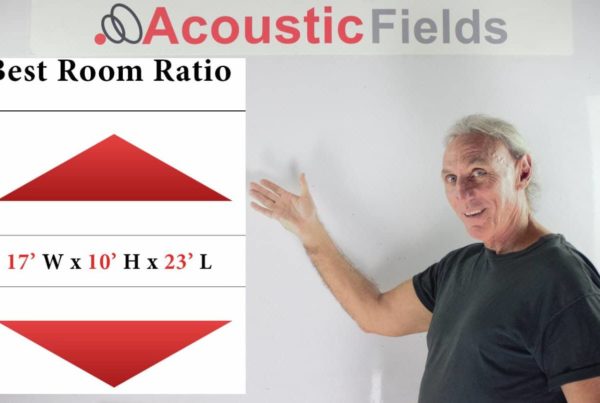Someone recently emailed in to ask “Can metal be used in a good sounding room? I was thinking of hiring a shipping container and using it as a studio” and I answered it in the following google hangout.
Dennis: Alright, we know, most of us know I think from our discussions with acoustics, that metal and glass are nasty. So you’re going to have an exterior shell of metal and I don’t know what the storage facilities are like in this person’s area but we have two storage facilities here as a company in Phoenix, Arizona and I wouldn’t put anything in it. I’m either wary about putting product in them. They rattle, they shake, they moan and they groan when it rains. When the wind comes, they leak. So as a barrier material they’re horrible. And you would have to put so much acoustical treatment on the inside especially with a 10-foot width, you came to me with a 10-foot width in your room and I tell you to find another room. That’s one of the worst dimensions that we can deal with on the width side. Height side it’s wonderful but on the width side it’s horrible.
So, on the length side it’s unacceptable, so not a good idea. It’s a shipping container so a good idea in theory because it’s pretty economical if you look at the rates for them, the places, you can get a pretty nice size space for a small amount of money and I understand where this person is going. They want to get some space cheap and it’s pretty quiet I would imagine in a storage facility especially at night when nobody else is there, so great idea just really bad barrier. And I think that barrier issue, everything will probably cause you more problems than you could ever try figure out and deal with so good idea just bad applications.
AD: Okay, final one for the week. Again from Anthony and this is understanding the room frequency response video. He says “I have a very bright sound when I record. It sounds very clear. I was just wondering whether carpet would make the sound warmer, professional mixes or is there any way to do that with acoustic treatment?
Dennis: Well this is of course about higher frequency issues. The brightness he talks about can be treated if it’s really bright. These are subjective terms so without looking at the room response curve it’s difficult to say but let’s just deal with the subjective part. Bright is not wanted because our digital music today is bright by definition so that’s the last thing that we want.
So the best way to approach this is to use sound absorption treatment. Is carpet a good idea? It’s a better idea than nothing. As far as being a good idea I don’t like it because it doesn’t have the necessary rates and levels to deal with music. Sound in general? Sure. Put carpet in your living room, that’s okay. So that your TV or video, when playing in the room, you don’t have high reverberation times. But I don’t like carpet for music because music is a control frequency response.
You know we have 20 to 20,000 Hz. that’s our range. Carpets are good for walking on but I don’t like it for room acoustic treatment because I don’t know its rates and levels of absorption. As a general sound absorbing product that fits a lot of variables, sure. But I don’t think it has any place for music.
AD: OK anything final you want to say Dennis? Any words of wisdom?
Dennis: Let me think if I can think of some examples that keep coming up. There seems to be a lot of confusion about diffusion. I think we need to do a confused about diffusion video. I think we need to do more videos in that area. People are just not understanding it and I get that. I’ve been working with it for 25 years. I think it took me 5 years to figure out. It’s not easy so I think we need, I think people are motivated they want to try diffusion and that’s great. It’s a really powerful tool in acoustics but the application of it is very, very critical and I think we need to add that to my video list to do because I got some ideas about that.
AD: Well actually you say that let’s answer a customers inquiry. Are the depths of the wall related to the lowest frequency that the diffuser can work with and the reason being is that I can make the diffuser to a little bit but not much deeper due to the short distance between the diffuser and the main listening position being around 6-foot and 7-foot.
Dennis: Okay, here we go again quantity versus quality. Making it taller, that’s quantity, no. Don’t ever think that more is better. Most of the time in room acoustics do no harm. Less is better so making something taller because you have the space available, makes no sense. Try to treat that particular room usage and the surface area together so that you get a result that you want, the result of room usage, the goal of the room. The musical and sonic goal of the room, it works backwards from that, it’s a control room.
Alright, control room has certain issues. Certain issues that pertain to diffusion, the main issue in control rooms is that rear wall. You don’t want to be sitting at your console and then hearing all of this energy coming back off the rear wall, hitting the monitor. Here’s a good example of the monitor between speakers, hitting the monitor and coming back in your face and what is the time signature of the reflection of the rear wall? Is it the same as the time signature out of your speakers? Can’t be, too much distance so it’s a delay. It’s called a slot back, that’s what the engineers call it. So you have all this slot back wash off the rear walls mixing with the direct energy from your speakers and your brain is struggling to find out what’s in the mix, what’s in the room. So we can’t do that. So we have to figure out that we have to control the energy in the room. We do that with diffusion on the rear wall so control room diffusion is good.
In Summary
To learn more about room acoustics and how drums interact with your room, please sign up to download our free ebooks and video series on room acoustics here. And please let me know if you have any questions at any time.
Thanks
Dennis Foley







